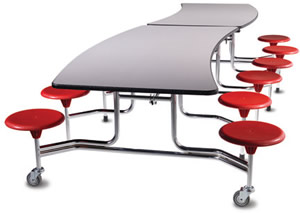BioFit Solution Extends Life of Mobile Folding Cafeteria Tables

BioFit’s adjustable torsion cap keeps older tables folding
and unfolding like the day they left the factory at
Monrovia Elementary School.
Monrovia Elementary School in Huntsville,
Ala., uses 27 BioFit 12-seat
mobile folding tables in its cafeteria. As
the 13-year warranty period for the tables
was coming to an end, facilities manager
Wayne Slater noticed the tables were becoming
more difficult to fold and unfolded
more quickly than they once had. Since the
tables were in excellent shape otherwise, he
contacted BioFit for help.
We informed Mr. Slater of a new, patent-pending
component developed by BioFit to
keep older tables folding and unfolding like
the day they left the factory: the adjustable
torsion cap. Regardless of the manufacturer,
mobile folding tables use a lift-assist
mechanism to facilitate safe and easy
folding. Over time, these mechanisms lose
torque, meaning it takes more force to fold
a table and to keep it from unfolding too
rapidly. Adjusting the torque level to original
specifications alleviates this problem.
BioFit provided the caps needed to retrofit
the Monrovia Elementary tables. Installation
was fast, easy and effective. Afterward,
Mr. Slater shared: “Since installing the
adjustable torsion caps, I can close the tables
with one hand. They work like new.”
Available on all new BioFit tables, the
adjustable torsion cap eliminates an age-old
issue with table lift-assistance devices.
By enabling the re-establishment of the
factory-specified lift capability, it facilitates
safe operation through the life cycle of the
product and allows customers to save money
by avoiding costly repairs or delaying the
need to replace failing tables. Additionally,
due to the relative ease of retrofitting, the
cap provides an economical way to refresh
the lift on older tables in the field.
The adjustable torsion cap is another
example of our mission to consistently
improve the learning environment.
www.biofit.com
This article originally appeared in the issue of .